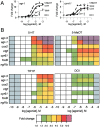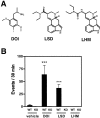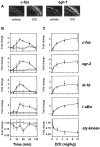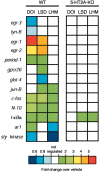Transcriptome fingerprints distinguish hallucinogenic and nonhallucinogenic 5-hydroxytryptamine 2A receptor agonist effects in mouse somatosensory cortex
- PMID: 14523084
- PMCID: PMC6740401
- DOI: 10.1523/JNEUROSCI.23-26-08836.2003
Transcriptome fingerprints distinguish hallucinogenic and nonhallucinogenic 5-hydroxytryptamine 2A receptor agonist effects in mouse somatosensory cortex
Abstract
Most neuropharmacological agents and many drugs of abuse modulate the activity of heptahelical G-protein-coupled receptors. Although the effects of these ligands result from changes in cellular signaling, their neurobehavioral activity may not correlate with results of in vitro signal transduction assays. 5-Hydroxytryptamine 2A receptor (5-HT2AR) partial agonists that have similar pharmacological profiles differ in the behavioral responses they elicit. In vitro studies suggest that different agonists acting at the same receptor may establish distinct patterns of signal transduction. Testing this hypothesis in the brain requires a global signal transduction assay that is applicable in vivo. To distinguish the cellular effects of the different 5-HT2AR agonists, we developed an assay for global signal transduction on the basis of high throughput quantification of rapidly modulated transcripts. Study of the responses to agonists in human embryonic kidney 293 cells stably expressing 5-HT2ARs demonstrated that each agonist elicits a distinct transcriptome fingerprint. We therefore studied behavioral and cortical signal transduction responses in wild-type and 5-HT2AR null-mutant mice. The hallucinogenic chemicals (+/-)-2,5-dimethoxy-4-iodoamphetamine (DOI) and lysergic acid diethylamide (LSD) stimulated a head-twitch behavioral response that was not observed with the nonhallucinogenic lisuride hydrogen maleate (LHM) and was absent in receptor null-mutant mice. We also found that DOI, LSD, and LHM each induced distinct transcriptome fingerprints in somatosensory cortex that were absent in 5-HT2AR null-mutants. Moreover, DOI and LSD showed similarities in the transcriptome fingerprints obtained that were not observed with the behaviorally inactive drug LHM. Our results demonstrate that chemicals acting at the 5-HT2AR induce specific cellular response patterns in vivo that are reflected in unique changes in the somatosensory cortex transcriptome.
Figures




References
-
- Aghajanian GK, Marek GJ ( 1999a) Serotonin and hallucinogens. Neuropsychopharmacology 21: 16S-23S. - PubMed
-
- Aghajanian GK, Marek GJ ( 1999b) Serotonin, via 5-HT2A receptors, increases EPSCs in layer V pyramidal cells of prefrontal cortex by an asynchronous mode of glutamate release. Brain Res 825: 161-171. - PubMed
-
- Aghajanian GK, Marek GJ ( 2000) Serotonin model of schizophrenia: emerging role of glutamate mechanisms. Brain Res Brain Res Rev 31: 302-312. - PubMed
-
- Arvanov VL, Liang X, Russo A, Wang RY ( 1999) LSD and DOB: interaction with 5-HT2A receptors to inhibit NMDA receptor-mediated transmission in the rat prefrontal cortex. Eur J Neurosci 11: 3064-3072. - PubMed
-
- Barnes NM, Sharp T ( 1999) A review of central 5-HT receptors and their function. Neuropharmacology 38: 1083-1152. - PubMed
Publication types
MeSH terms
Substances
Grants and funding
LinkOut - more resources
Full Text Sources
Other Literature Sources
Molecular Biology Databases
